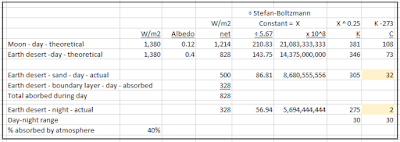The Consensus has no explanation as to why the 'Greenhouse Effect' is actually negative during the day; the surface is a lot cooler than it would be without any atmosphere whatsoever; but at night, the 'Greenhouse Effect' is larger than what they say it is (average 33 C at the Earth's sea level). It's impossible to disprove their basic logic by comparing predictions with outcomes because they keep bolting bits on, like the pre-Copernican model of the Solar System, to the extent that there isn't any coherent logic to disprove (believe me, I have tried working backwards from the IPCC's Global Energy Budget and couldn't reconcile it between day and night).
-------------------------------------------------------------
So that's today's chapter of my never-to-be-published book. Instead of trying to make sense of The Consensus, let's see if we can explain it using common sense and basic physics/maths and see where that gets us.
1. The sensible assumption is that the atmosphere acts like a blanket, it is warmed up by day (while shielding what is beneath it from the extreme highs) and gives off/loses that stored warmth by night. (An Economy 7 heater does the opposite). And that would be correct, but we shouldn't take analogies too far, so let's do the numbers.
2. We set up our spreadsheet again and type in the variables to predict hard surface temperatures for the Moon and a desert at the Equator on Earth, just to make sure we get sensible answers. The Moon can get a bit hotter than 108 C, but its day is much longer, so that looks about right.
3. Deserts do not all warm to 73 C - that's the clue bat! The typical/average day time temperature is 32 C, this works backwards to 500 W/m2 being received. At night the deserts cool to just above freezing, which works backwards to 328 W/m2. Those 328 W/m2 aren't coming from the Sun (it's night time), they are coming from the boundary layer. That gives us a typical diurnal temperature variation of 30 C and total average W/m2 received/emitted of 828 W/m2 over 24 hours. (To use two fancy new phrases I learned recently).
4. When the sun is directly overhead at the Equator, total 1,380 W/m2 is coming in (Joules per second per m2), of which 40% is reflected (albedo = 0.4). Of the 60% = 828 W/m2 which is absorbed/stored as warmth, the hard surface absorbs 60% (500 W/m2) of that and the boundary layer absorbs 40% (328 W/m2) so it all reconciles very nicely (after some trial and error).
5. As you can see, we do not require any magical and mysterious 'back radiation' from 'greenhouse gases'; we do not need to distinguish between conduction, convection and radiation (and whether or not the air can absorb infra red). And it's the dry desert, so we don't need to worry too much about the Latent Heat of Evaporation/Condensation. We just need to apportion the total energy budget (828 W/m2) sensibly between hard surface and boundary layer; between day and night; between warming and cooling etc to get sensible answers.
Here are the workings for you to reverse engineer and check. 32C and 2C are highlighted yellow to show they are my assumptions, the maths then follows as sure as night follows day...

